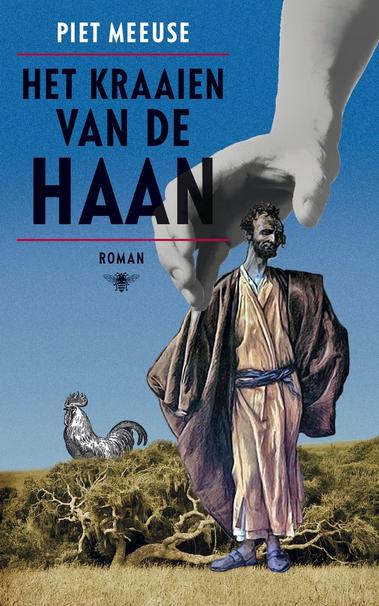Vrijblijvende science-fiction
De Amerikaanse auteur Gore Vidal vindt dat Life from Golgotha behoort tot zijn beste werk, maar hij vormt een minderheid. De meeste critici oordeelden dat de ouwe rot niet echt op dreef was in zijn exuberante verhaal over tijdreizigers die in Jeruzalem de kruisiging van Jezus bijna in het honderd laten lopen. Toch moet je Vidal nageven dat hij het komisch potentieel van een tijdreis volledig uitbuit. Dat kun je niet zeggen van de imitatie van de Amerikaanse satire die Piet Meeuse schreef. Het kraaien van de haan wil de lezer maar niet aan het lachen krijgen – en dat is dodelijk voor een boek waarin het belang van humor een centrale rol speelt.
Meeuse en Vidal
De imitatie ligt er duimendik bovenop: evangelische christenen uit de nabije toekomst willen beelden van de kruisiging, er worden tijdreizen gemaakt, Jeruzalem en Efese vormen het decor, Jezus en Judas zijn niet wie we denken dat ze zijn, de relatie tussen geweld en religie komt aan bod, Paulus blijkt de historische waarheid niet te kennen en de eigenlijke vertelling eindigt met een ironische cliffhanger waarbij de lezer al weet wat er zal gebeuren, maar de personages niet. Toch is Het kraaien van de haan een voldoende creatieve kopie om niet te hoeven doorgaan voor plagiaat, want zelfs al is de substantie identiek, de uitwerking is anders.
Zo vermijdt Meeuse een fout van Vidal. Waar deze wel heel gemakkelijk aanneemt dat religie van nature gewelddadig is – zijn Jezus is bepaald onsympathiek – stelt Meeuse tenminste de vraag waarom religie zo vaak ontaardt in fanatisme. Die vraag is goed en zijn antwoord vormt een sleutelscène in het boek, namelijk het punt waar de wegen van Judas en Jezus uit elkaar gaan:
Ik weet dat ik daarover lang heb liggen nadenken die nacht en dat ik tot de conclusie kwam dat dat de achilleshiel was van ieder ‘waar geloof’: het kon zichzelf niet relativeren. Daarom … liepen religieuze conflicten altijd uit op haat en bloedvergieten. De irrationele zekerheid van het geloof voelde zich bedreigd door de lach, want lachen was een soort exorcisme: een heilzame kramp waardoor alle valse zekerheden schoksgewijs werden uitgedreven.
Humor
Helaas is dit antwoord – waar geloof laat zich niet door humor relativeren – even sympathiek als onjuist. Sympathiek, want humor is inderdaad wat mensen menselijk maakt. Onjuist omdat de generalisatie verkeerd is. Immers, veel geloofsvirtuozen wisten dat menselijke kritiek de ervaring van het goddelijke nooit zou aantasten. Erasmus en Gandhi zijn voorbeelden, en voor Meeuses boek is de Mishna relevant: een kloeke collectie rabbijnse wijsheid, waarin discussies regelmatig worden afgerond met een witz. Het zijn juist mensen zónder onwankelbaar geloof die niet tegen een grapje kunnen en de Aries Boomsma dezer wereld eruit schoppen bij de EO.
Het is jammer dat Meeuses hoofdpersoon geen overtuigend antwoord biedt op een vraag die aandacht verdient, en helaas heeft het boek meer zwaktes. Het citaat hierboven toont bijvoorbeeld al dat antwoorden expliciet worden verwoord. Meeuse laat weinig over aan de verbeelding van de lezer en dat maakt het verhaal nogal voorspelbaar. Als aan het begin van Het kraaien van de haan de ik-figuur, zo’n twintig jaar na de gebeurtenissen in Jeruzalem, een indrukwekkende vrouw terugziet, weet de lezer meteen wie dat is – en op blz.69 blijkt dat vermoeden te kloppen. Als het apparaat waarmee tijdreizen mogelijk is zoek blijkt, weet je onmiddellijk wie daar achter zit. De volgende zeven pagina’s uitleg zijn overbodig.
Vrijblijvendheid
Maar het echte probleem is de vrijblijvendheid van het boek. Het eeuwige probleem met fictie is dat het de lezer alleen aan het denken zet als de beschreven wereld geloofwaardig is. Dat zou in dit geval moeten betekenen dat Meeuse de figuur van Jezus van Nazaret adequaat portretteert, maar in plaats daarvan schetst de schrijver een beginnend christendom zoals men het zo’n veertig jaar geleden reconstrueerde.
Alleen Mel Gibson lijkt in onze tijd nog te denken dat de historische Jezus iets anders kan zijn geweest dan een joodse Jezus, en iedereen die de krant een beetje bijhoudt, weet dat bij zo’n joodse Jezus de uitleg van de Wet centraal moet staan. Niets daarvan bij Meeuse. Misschien is dat omdat joodse wetuitleg vaak geestig is – denk aan de grappige juridische drogreden in Johannes 8.17-18 – en dus onbruikbaar voor een schrijver die een Jezus wil schetsen zonder humor.
Er zijn meer plaatsen waar Meeuses kennis uit de tijd is. De overspelige vrouw uit Johannes 8.1-8 is bij hem Maria Magdalena (staat er gewoon niet); de zeloten spelen een belangrijke rol (de stroming ontstond pas dertig jaar na Jezus). Het is allemaal niet vreselijk erg, maar als Meeuse zich had verdiept in de joodse Jezus – en veel meer dan de opiniebladen bijhouden was daar niet voor nodig – zou hij een geloofwaardiger wereld hebben geschetst. Dan had hij een boek geschreven dat niet alleen zinvolle vragen opwierp, maar die ook met gezag beantwoordde. Het is alsof je Jesus Christ Superstar hoort: je weet dat het allemaal niet zo is geweest, en dus heeft het geen relevantie.
Gekke fouten
Wat overblijft is een redelijk spannend boek met enkele mooie personages. Door het gebrek aan urgentie ga je echter letten op fouten waar je anders overheen zou hebben gelezen. Waarom zouden joodse kolonisten de El-Aksamoskee opblazen? Ligt de Rotskoepel niet meer voor de hand? Is het werkelijk denkbaar dat een classicus nog moet ontdekken dat in de Oudheid religie automatisch politiek was? Waarom de simplistische tegenstelling tussen religie en wetenschap als vertrekpunt genomen, terwijl de eigenlijke discussie alweer een eeuw gaat tussen enerzijds gelovigen en wetenschappers die menen dat hun kenwijzen geen raakvlakken hebben en anderzijds gelovigen en wetenschappers die menen dat dit wel zo is?
Erger is dat er niet één geslaagde grap in zit. Vidal wist het komisch potentieel van een tijdreis beter uit te buiten door Jezus een kerk te laten binnenwandelen, Paulus de follow-up-mail te laten uitvinden en een van de personages te laten opmerken dat Pilatus wel wat leek op David Bowie. Vidal voert zichzelf ten tonele als bewoner van Rome en schetst een zelfportret dat even vilein is als zijn portret van Jezus. De Amerikaanse schrijver ontziet niets en niemand, en boeit daardoor méér. Piet Meeuse mag dan sympathieke dingen zeggen over het belang van humor, het is Gore Vidal die begrijpt hoe humor werkt.
[Deze recensie verscheen eerder op Recensieweb.]
#DesideriusErasmus #GoreVidal #historischeRoman #JesusChristSuperstar #JezusVanNazaret #MahatmaGandhi #MelGibson #Mishna #PietMeeuse #roman






